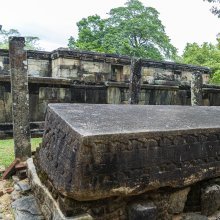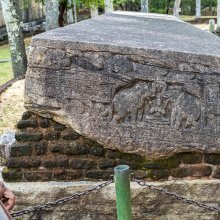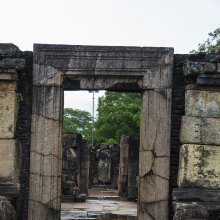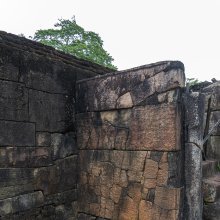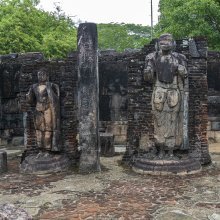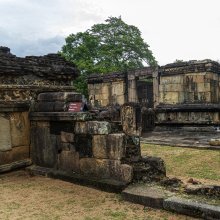Nissanka-malla, Nissankamalla, Niśśaṅkamalla: 2 definitions
Introduction:
Nissanka-malla means something in the history of ancient India. If you want to know the exact meaning, history, etymology or English translation of this term then check out the descriptions on this page. Add your comment or reference to a book if you want to contribute to this summary article.
Images (photo gallery)
(+21 more images available)
India history and geography
Source: Wikipedia: India HistoryNissanka Malla was a king of Polonnaruwa (Sri Lanka) who ruled the country from 1187 to 1196. He is known for his architectural constructions such as the Nissanka Lata Mandapaya, Hatadage and Rankot Vihara, as well as for the refurbishment of old temples and irrigation tanks. A rock inscription made by Nissanka Malla at Dambulla mentions that he is of the Kalinga dynasty and a descendant from the race of Prince Vijaya. Another inscription at Ruwanwelisaya describes him as being a member of a royal family of Kalinga, born at Sinhapura.
Nissanka Malla (Sinhala: නිස්සංක මල්ල, Nissaṅka Malla) is also known as Keerti Nissanka and Kalinga Lokesvara.
Source: academia.edu: The Chronological History of Ancient Sri LankaKalinga King Nissanka Malla brought the tooth relic of Buddha to Sri Lanka and became the king. Nissanka Malla was the son of Kalinga king Jaya Gopa and Parvati devi. Probably, Simhapura of Srikakulam or Jajpur was their capital. Nissanka Malla claimed that King Vijaya indeed belonged to his capital Simhapura and himself was the descendant of him. He built Dambulla Vihara. Interestingly, Nissanka Malla says in his Anuradhapura inscription that he bestowed Kambodis (Cambodians) gold, cloths etc. and commanded them not to kill birds (EZ, vol II, pp. 70-83).

The history of India traces the identification of countries, villages, towns and other regions of India, as well as mythology, zoology, royal dynasties, rulers, tribes, local festivities and traditions and regional languages. Ancient India enjoyed religious freedom and encourages the path of Dharma, a concept common to Buddhism, Hinduism, and Jainism.
See also (Relevant definitions)
Partial matches: Malla, Nihshanka.
Full-text: Kittinissanka, Pandu.
Relevant text
Search found 8 books and stories containing Nissanka-malla, Niśśaṅka-malla, Nishshankamalla, Nishshanka-malla, Nissankamalla, Niśśaṅkamalla, Nihsankamalla, Nihsanka-malla; (plurals include: mallas, Nishshankamallas, Nissankamallas, Niśśaṅkamallas, Nihsankamallas). You can also click to the full overview containing English textual excerpts. Below are direct links for the most relevant articles:
The history of Andhra country (1000 AD - 1500 AD) (by Yashoda Devi)
Part 4 - Singaladeva (A.D. 1247-1253) < [Chapter XIV - The Yadavas]
Part 7 - Madhava II (A.D. 1272) < [Chapter XIV - The Yadavas]
Part 4 - Choda II (A.D. 1163—1180) < [Chapter I - The Velanandu Chodas of Tsandavole (A.D. 1020-1286)]
A Short history of Lanka (by Humphry William Codrington)
Chapter IV - The Polonnaruwa Kings (1070 AD—1215 AD)
Chapter III - The medieval kingdom to the Chola conquest in the eleventh century (479 AD—1070AD)
Vastu-shastra (5): Temple Architecture (by D. N. Shukla)
Temple architecture in Ceylon (Sri Lanka) < [Chapter 12 - History of Hindu Temples (Prāsādas and Vimānas)]
Later Chola Temples (by S. R. Balasubrahmanyam)
Part I - Manavalap-perumal and Kopperunjinga < [Chapter XVII - Chola-Pallava Phase (The Later Pallavas)]
Mahavamsa (by Wilhelm Geiger)
Dipavamsa (study) (by Sibani Barman)
